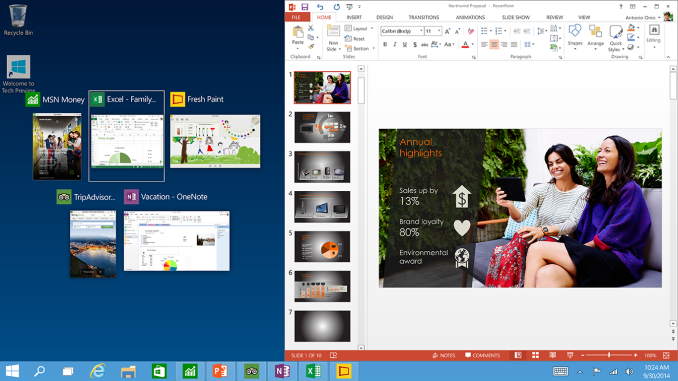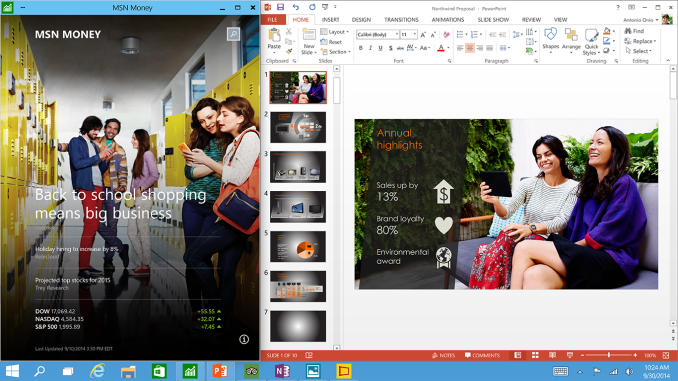Windows 10 Technical Preview First Impressions: The Return Of The Desktop
by Brett Howse on November 13, 2014 8:00 AM EST- Posted in
- Software
- Microsoft
- Windows 10
Closing Thoughts
If Windows 8 was “Touch First” then clearly Windows 10 is not. The current technical preview is very much geared towards the traditional mouse and keyboard user. This will change of course over the next several months, as the touch features get integrated back into Windows 10. As a user of all types of Windows devices, I welcome this change. It allows me to be more productive on my desktop, but still use the touch based Start Screen on a tablet or convertible notebook. Some good things have been done here to hopefully embrace the current user base, as well as new device types.
There are a number of features aimed squarely at businesses. If Microsoft wants to avoid another Windows XP with Windows 7 – where businesses do not migrate until they absolutely have to – then these features are certainly a carrot that may entice them to at least try it out. The Start Menu and other desktop additions will be great for the business users, and I think the IT crowd will be happy with a lot of the new additions around device management, identity management, and information management.
This is a technical preview of course, but still I would be remiss to not mention that it is not without its bugs. I have had a lot of issues with Windows Store apps, with many of them crashing especially when they are not the active window. Possibly there are some changes to the underlying WinRT framework for apps in standby but until we hear more about the framework changes then these problems will likely continue. More of this information should come out around the time of the next BUILD conference, scheduled for April 29th to May 1st 2015. Other issues with WinRT apps currently is that even though they can be used in a window, the absolute height of the window is limited. When Windows 8 was launched, WinRT apps were expecting to be either full screen, or snapped to the side. As such, the apps in a window must maintain a minimum height. Hopefully this can get sorted out in the future.
At first glance, Windows 10 looks like Windows 8 with a Start Menu. It is clearly a lot more than that, but even so, as someone very smart told me, that’s not a bad thing. Windows 8 had a lot going for it, but design decisions were made early on, and with a “my way or no way” attitude that it was difficult to use. It seems that Windows 10 really addresses a lot of this, while at the same time keeping and expanding on a lot of the great features that were in Windows 8 and likely overlooked due to a lot of animosity towards it.
The Windows Store is going to be a big part of this, and if the rumors of desktop apps being integrated into the store is true, then the OOBE for Windows 10 will be amazing. All of your settings and apps will now follow you from device to device, with a single log in. A lot of that is already there with Windows 8, but 10 should finish off the last remaining pieces if this is true. It makes a lot of sense, so unless the licensing terms are awful, this could be a fantastic addition to the store.
The Universal App model is also a big piece of the puzzle, but here there is more work to do. WinRT has a lot of advantages, but the framework needs to be updated at a rapid pace in order to draw developers in. It is somewhat seductive to be able to target desktops, laptops, tablets, phones, and the TV with Xbox One with a single application (with multiple interfaces of course) but until the framework is made powerful enough for more apps than just simple web front ends, it may be difficult to realize this idea. Once again, more info should be available at BUILD in regards to this.
I’ve also had some bugginess with the WinRT apps on Windows 8, which I hope will be fixed with Windows 10. At this point though, the WinRT apps are even buggier so likely there will be more pain before this is all corrected.
Although we have only seen the Technical Preview and a single update to it so far, you can see the potential for Windows 10 and what it will be able to accomplish. It is an ambitious goal to provide a single platform across such a swath of different devices, and one that was held back by the user interface before. With Continuum, it appears that it may be the best of both worlds. Even more exciting is how much more upfront and open Microsoft has been on this entire process, with not just the technical preview but also soliciting and requesting user feedback on the changes. One of the biggest change requests was a simple animation on the Start Menu, and that has already been implemented, so this really is a different world than when Windows 8 was given a sneak peek.
Due to the timing of the latest release that just came out, this article is based on the second build of Windows 10 and I have not had a chance to go over any of the changes in the latest built that arrived on November 12th.
Going forward, as we get more updates to the preview we will do our best to keep you fully informed with that the changes are, and how they will affect you. If you want to kick the tires of Windows 10 and you have not yet, just visit http://preview.windows.com and sign up for the technical preview.












198 Comments
View All Comments
piiman - Saturday, November 15, 2014 - link
"The problem with that is they force you to use those features and become familiar with them before they take them out."How did they force you to use those features? I personally hate libraries and never use them I just open explorer and go to the location I have it saved, I'll do my own filing thank you.
taltamir - Monday, December 29, 2014 - link
1. Everyone told them this idea was stupid to begin with and they insisted on doing it anyways2. Beta testing is a thing, you can test features without putting them in the final version.
3. You can actually add an alternative option rather then removing the current method of doing things. If people got a choice between aero and that metro shit there wouldn't be a problem. But they removed aero because they didn't want people choosing to not use metro. They overestimated their power over users.
4. Having support for multiple APIs does not, in fact, make an OS unmanageable.
damianrobertjones - Thursday, November 13, 2014 - link
MS knows what people use and, in all honesty, libraries was probably one of those features that most users ignored. Businesses still used the older way of doing things (Direct folder re-direction) so just because YOU use something it doesn't mean the rest of the world does.P.s. I still use Libraries in Windows 8.1.
Ubercake - Friday, November 14, 2014 - link
Church. Updates aren't a new concept. This should be a non-issue at this point in technology. I've also had issues with printers showing as offline in Win 8 while all of my Win 7 PCs, iPhones and Android tablets can print to it. Printing is another thing that should be a non-issue. Also, something you occasionally see across Win installs (I've seen it in 7 and 8) is the login service not starting on a multi-user install. WTH is right. Logging in, printing, updates... All fundamental concepts. If you can't get these things right, you need to step away and revisit the basics before thinking you can start adding on.That being said, while previously being a large opponent of making the move to Win 8, I have forced myself to use Win8.1 Pro for the past couple of months on a souped-up workstation and the way I see it now is Win 7 - though stable and trusty - is a pretty old-school OS. I now see the metro screen as my very own portal page that will take me to my most-used apps and web resources. The other thing I like about the metro screen is the ability to just start typing to get to things like admin tools and the like. While I do most of my work in the desktop, the metro interface really is a quick way to get to things similar to a 'Jump page' or personal portal page.
Win 10 will hopefully get things right when it comes to those basics because the way I see it is if you can't get those things right after 40 years of designing operating systems, you need to revisit your process.
mebby - Friday, November 14, 2014 - link
How MS released Win8 and did not allow to boot in to desktop and keep Start Menu was a huge mistake. But I have used Win8/8.1 everyday and generally remain in the desktop. In many ways it feels like am using Windows 7. So it is not an ongoing disaster like many bloggers/journalist state. I stay in desktop... almost all day.But I also use a Win8.1 tablet everyday and really like the touch UI.
So I am also hoping that MS improves both the desktop and mobile experience in Win10. But I am doubtful. Seems like MS keeps changing direction and tripping over themselves even when they have good or great ideas.
Flunk - Thursday, November 13, 2014 - link
"Unlike apps written in .NET, WinRT is native code, which should result in better performance."This is actually not true. WinRT apps can be written in C++ (fastest), .NET (nearly as fast) or HTML/Javascript (slow). And the performance difference between C++ and C# specifically has shrunk significantly over the years, I might even argue that for desktop applications it doesn't really matter. WinRT is a good idea because it's fairly inclusive of different programming styles.
Flunk - Thursday, November 13, 2014 - link
Oops, I didn't intend to make that a reply.nevertell - Friday, November 14, 2014 - link
Whilst you can use the WinRT framework in different languages, the libraries and the framework itself is implemented in native code, hence execution will be fast.GatesDA - Thursday, November 13, 2014 - link
The rumor is that Win10 will be a free upgrade for Windows 7 users. The Technical Preview showed up as an option in my Win7 Windows Update, which adds credibility to the rumor.MonkeyPaw - Thursday, November 13, 2014 - link
Yeah, I think MS will be offering this for free or cheap for all legit Windows users (though I'm sure enterprise markets won't be free). Why? They need the Store to succeed, and Windows 10 will also be the best at platform sync, which should help sell all of MS's devices and services.